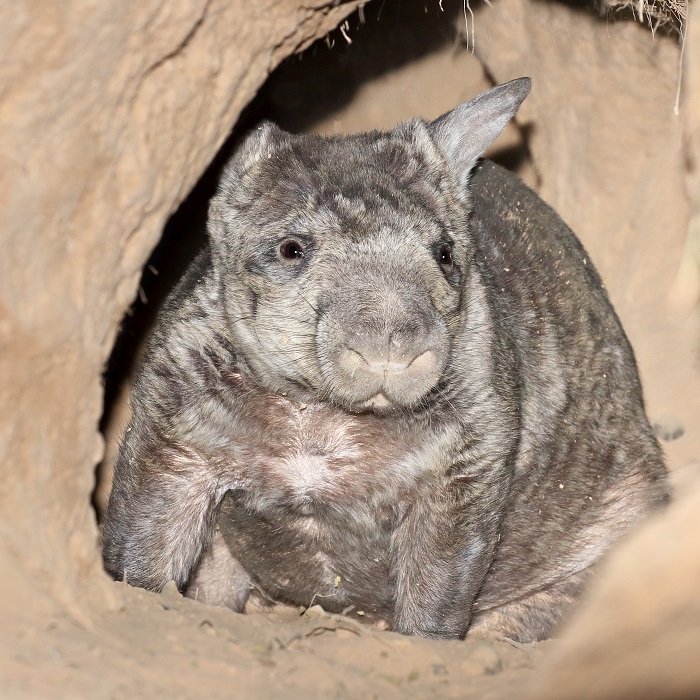
Australia’s northern hairy-nosed wombat populations are on the recovery after being almost wiped out by wild dogs. Image – Wombat Foundation.
ONE of the world’s most endangered wildlife species – the northern hairy nosed wombat – is making gains in its fight against habitat loss and predation by wild dogs and dingoes.
Wild dogs and dingoes remain the key threat to the survival of the critically endangered mammals, but a small Queensland population is recovering thanks to a collaborative plan.
The last remaining population of the species was almost wiped out by wild dogs 20 years ago, but thanks to the recovery plan, it has recovered sufficiently to allow the establishment of a third population in Australia.
There are now no northern hairy-nosed wombats on private lands in Australia and the species only exists in two predator-proof enclosures at Clermont and St George in Queensland.
The northern hairy-nosed population sunk to a low of 35 individuals at Clermont in 2002, but now numbers 300 following a recovery program led by the Queensland Department of Environment and Science, supported by key stakeholders including the Wombat Foundation.
Wombat Foundation director Leanne Brosnan said the essential components of this success have been the increased understanding of the species requirements, protection of habitat, exclusion of predators, securing of food and water resources and establishing a second population.
“Although the species current trajectory is promising, it remains arguably the most critically threatened mammal in Australia and the world.
“It is more endangered than the Giant Panda or Sumatran tiger and is listed in the top 100 critical species in Australia under the Australian Government’s Threatened Species Action Plan 2021-2026,” Mrs Brosnan said.
More than 95 percent of the current populations are located at the Epping Forest National Park, Clermont, and the remaining 15 individuals protected in a small, translocated population at Richard Underwood Nature Refuge, St George.
The Wombat Foundation has received a $248,000 grant under the Australian Government’s Environment Restoration Fund – Threatened Species Strategy Action Plan – Priority Species Grant program.
The project will deliver crucial on-ground actions identified as priorities including improvements to the existing dog proof fence at Epping Forest National Park, improved genetic health and size of the St George population, improved habitat, and informed predator and competitor management strategies.
“At European settlement, the species existed in small colonies from Deniliquin, in southern New South Wales, to central Queensland, and the introduction of grazing animals combined with drought and their natural predators placed pressure on the populations,” Mrs Brosnan said.
“Their main natural predator is the dingo, wild dog and their hybrids and the wombats are most vulnerable to predation when they come out of their burrows to graze.
“The turning point for the population was installing the predator-proof fencing around 2750ha within the Epping Forest National Park to protect them from dingoes and wild dogs,” she said.
“Part of the on-ground activities the Foundation is funding through the Commonwealth Environment Restoration Fund is to put a skirt around the fence at Epping Forest to keep the wombats in and predators out.
“The predator proof fence eliminated the dingo/wild dog problem inside the sanctuary and the upgrade to the fence will ensure that continues in the future,” Mrs Brosnan said.
“The monitoring of the prospective third site will allow the department to make the right decisions on fencing going forward.”
Mrs Brosnan said although dingoes and wild dogs had been completely excluded from within the sanctuary, the exclusion fence was constantly monitored for incursions.
Remote cameras also monitor selected burrows, and food and water stations while tracks are swept to pick up any wild dog paw prints with any incursions immediately followed up.
Mrs Brosnan said the wombat population had recovered to the point that a third sanctuary was required.
“Wombats were trapped at Epping Forest in 2009 and flown to the 130ha Richard Underwood Nature Refuge to establish a second population,” she said.
“Genetically diverse individuals will be trapped at Epping and used to establish a third population within a predator-proof enclosure to help shore up the species.
“Remote cameras will monitor the predators and other wildlife to determine the pest management strategy.”
Mrs Brosnan said farmers were great land managers and their work complemented the management programs undertaken by Queensland Parks and Wildlife to protect the wombat.
“The predator proof fence is the ideal non-lethal tool to manage the dingoes as far as the wombats are concerned,” she said.
“One of the main drivers of the Wombat Foundation is to increase awareness of this amazing third wombat species in Australia and their story of survival, and how important their conservation is.”
National Wild Dog Action Plan Coordination Committee chair Geoff Power welcomed the news of the establishment of a third sanctuary for the northern hairy nosed wombat.
“Landholders support increasing biodiversity and protecting wildlife. In our case in South Australia, western quolls have been reintroduced to Ikara-Flinders Ranges National Park as landholders have baited around the park perimeter in conjunction with targeted baiting inside the park,” he said.
“The quolls are doing well and are breeding – the same has occurred with the yellow-footed rock-wallaby.
“Landholders are about managing a sustainable landscapes and part of that is pest species.”
Access a fact sheet here on the northern hairy-nosed wombat (to upload) or to read research into the impacts of dingoes, wild dogs and their hybrids on rare and threatened native fauna click here.



Any excuse to eradicate native dingoes to ultimately protect the environmentally destructive sheep industry that caused this problem in the first place.
The main threat to the wombat is loss of habitat by the introduction of sheep and cattle and the farmers who have been killing the animals by covering their burrows and allowing them to suffocating or die of starvation. Predation by dingoes would be minimal.